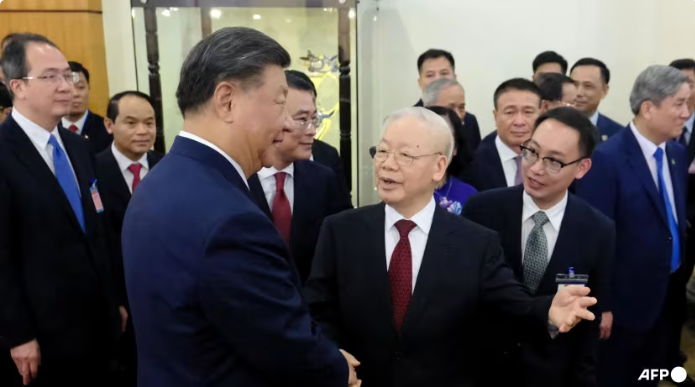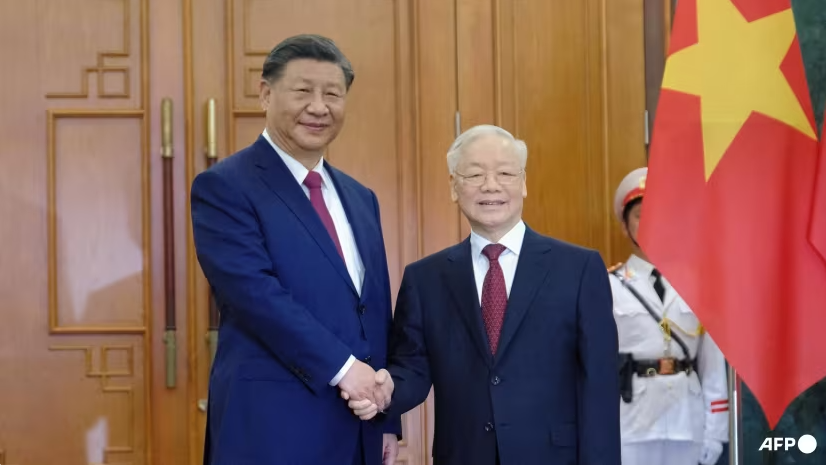After a dispute over the South China Sea claims, China and Vietnam agreed to strengthen ties on Tuesday (12 December) and create a community that has a “shared” future, three months after Hanoi improved its formal relations with America.
On Chinese president Xi Jinping’s first visit Hanoi in six years, both countries announced 37 agreements, including those on diplomatic ties and railways.
Analysts and diplomats say that the improvements in relations may be more symbolic rather than real, as China and the United States compete for influence in this strategic nation.
Vietnam has agreed to “support” the initiative to build a community for a shared future of humanity, according to a statement presented to reporters by sources on Tuesday. China was said to have been pushing this. The joint statement will be signed formally on Wednesday.
Officials and diplomats say that the countries’ diplomats debated “shared future” for months after Hanoi initially resisted using it.
In English and Vietnamese, the term “common future” is used instead of “common destiny”, which can be viewed as less demanding.
A diplomat in the Vietnamese capital commented on the meaning of the phrase by saying “One declaration many translations”.
Le Hong Hiep said that the upgrade in diplomatic relations is symbolic. He is a specialist on Vietnamese strategic and political matters at Singapore’s Iseas Yusof Ishak Institute.
He said that Vietnam’s distrust of China is deep and there’s little or no “shared destiny” between the two nations as long as China continues its claim to the South China Sea.
The neighbours, despite their close economic ties have had a long history of conflict over the South China Sea’s boundaries.

According to the agreement, in a possible sign of de-escalation they have signed two agreements of cooperation for joint patrols of the Tonkin Gulf and the South China Sea, as well as to establish a hotline that will handle incidents involving fisheries.
According to a Vietnamese official, this was less than the 45 originally proposed and it missed out on agreements on rare earths and critical minerals, on which Xi had urged greater cooperation in an article published Tuesday in a Vietnamese government newspaper.
Two memoranda were signed on the development of rails across borders, one of which mentioned developing aid.
Both countries’ top officials have urged the development of a rail connection between the Chinese city of Kunming in the south and the Vietnamese port of Haiphong in the north, which passes through regions of Vietnam rich in rare-earth minerals.
China’s ambassador in Vietnam, Xiong Bo, said this week that Beijing is ready to offer grants for the development of rail connections. However, the amount and terms of any possible loans remain unclear.
Beijing is looking to integrate its northern supply chain network with the southern one, where Chinese companies are moving their operations.
The Belt and Road Initiative of China (BRI) would be expanded by a stronger rail network, which would allow components to be imported from China and assembled in Vietnam.
The Hanoi Metro is the only project in Vietnam to receive BRI loans. It hasn’t been labeled as a part of the initiative because the leaders are often battling widespread anti-Chinese sentiment.
Both countries have agreed to promote jointly the “two-corridors, one-belt” initiative. This is the Vietnamese name for the infrastructure projects that China supports.
Xi’s visit will also boost plans for the Digital Silk Road. The two countries have signed several agreements to collaborate on telecommunications, digital economy and other areas.
Officials have not revealed the content of the agreement, but they had stated that the increased cooperation in telecoms could include digital infrastructure like 5G networks and underwater optical fibre cables.
